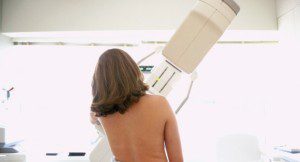 Mammography or a mammogram is an x-ray examination of the breast tissue. Mammography has been used for years to detect and diagnose breast diseases in both women and men. While most mammography is done on a screening basis, it is crucial in diagnosing the cause of breast symptoms such as breast lumps, breast pain, and nipple discharge.
Mammography or a mammogram is an x-ray examination of the breast tissue. Mammography has been used for years to detect and diagnose breast diseases in both women and men. While most mammography is done on a screening basis, it is crucial in diagnosing the cause of breast symptoms such as breast lumps, breast pain, and nipple discharge.
What is a Screening Mammogram?
Screening mammograms are performed on patients who are asymptomatic (has no breast complaints) and meet the criteria for a mammogram. These criteria are generally age(over the age of 40), and family history of breast cancer. A screening mammogram usually involves imaging of both breasts the number of images depends on the patient.
The goal of a screening mammogram is to detect breast cancer when it is still too small to be felt by either the woman or her physician. Early detection of small breast cancers by screening mammography dramatically increases the chances for successful treat of the disease. In the U.S., one out of eight women will develop breast cancer during her life. The earlier the disease is diagnosed, the higher the chances of a complete cure. When breast cancer is detected in the localized stage without spread to lymph nodes, the five year survival rate is 98%. If the cancer has spread regionally to the axillary (underarm) lymph nodes the rate drops to 76%.
If you experience unusual tenderness, pain, nipple discharge or notice a lump in your breast (even if you are in your early twenties), contact your personal physician immediately and come in for a diagnostic evaluation. The best treatment for breast disease is early detection.
• Women 20 years of age and older should perform breast self-examinations monthly
• Women 20-39 should have a physical examination of the breast every three years, performed by a health care professional such as a physician.
• Women 40 and older should have a physical examination of the breast every year.
• Women 40 and older should have a mammogram every year.
What is Diagnostic Mammography?
Diagnostic mammograms are performed on patients with a breast complaint (for example, a breast lump, pain or nipple discharge etc.) or have had an abnormal screening mammogram. During a diagnostic mammogram, additional imaging of a breast abnormality will be taken and carefully evaluated. These images may include coned view with magnification, which increases the appearance of an abnormality and makes it easier to see. The additional views to be obtained are tailored to the patients needs by the Radiologist. This commonly will include an ultrasound of the area, but not always. During this visit the Radiologist will come and speak with you about your results.
A complete diagnostic work up may show that a lesion or area of abnormal tissue has a high likelihood of being benign (not cancer), and although the Radiologist may believe that the chances of this area developing into cancer are low, you may be asked to have the area re-imaged in a few months. Or the diagnostic mammogram may show that the area is not of concern and you will then be instructed to continue your routine screening mammograms.
Finally a diagnostic mammogram may suggest that a biopsy is needed to tell whether or not a lesion is cancer. Mammography cannot prove that an abnormal area is cancer. If mammography raises a significant suspicion of cancer, tissue must be removed for examination under a microscope to tell if it is cancer with certainty. This is can be done by needle biopsy or open surgical biopsy. A recommendation of biopsy does not necessarily mean that the abnormality is cancer. About 70% of all breast lesions that are evaluated with biopsy are found to be benign. When a biopsy is recommended the patient should discuss the different types of biopsy with their physician to determine which method of biopsy is best for her.
You can feel comfortable in having your mammogram done at NDIC. The Radiologists at our Imaging Centers are highly trained and are the most respected Physicians in the field of mammography. NDIC performs over 20,000 mammograms annually, so we pride ourselves in helping women detect breast disease, as well as, help them through the processes of getting treatment if needed. With the use of digital imaging and computer-aided detection (CAD) NDIC can image the interior of the breast with a high rate of accuracy. We use only state-of-the-art equipment and are certified and accredited by the American College of Radiology and the FDA. Both the Radiologist and Technologist at NDIC maintain the highest level of training in the area mammography.
To learn more about the mammography and other imaging services available at Naples Diagnostic Imaging Center, please call (239) 593-4222.








